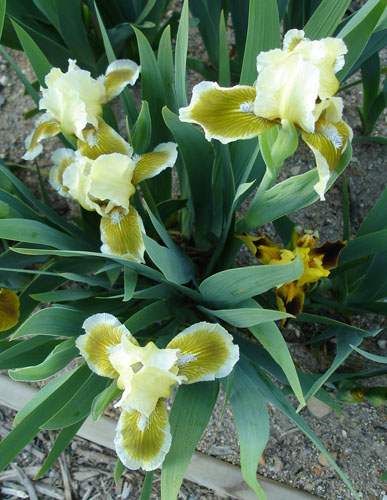Photography, soil conditions, and climate can all have an effect on how green an iris appears. In the last post, we asked what the greenest of the green irises were, and we saw quite a bit of variety. Actually, there are more irises in the green range than I could include in the prior post-- and one or two that I have to confess I overlooked -- so here are more, some with pronounced differences in the coloration of the individual specimens, seemingly reflecting the conditions in which they are grown.
Veins
This striking seedling of Bob Van Liere tops the Veins category. We certainly hope to see this one in commercial production.
Van Liere sdlg 24EM5
It was hard to decide into which category to place Mike Sutton's 'Return to Bayberry', but Colleen Modra's photo from Australia tipped the balance to Veins.
'Return to Bayberry' Michael Sutton Photo by Colleen Modra
| 'Return to Bayberry' Michael Sutton |
Chartreuse
Richard Ernst's 'Envy' leads the list in this category -- and a wide category it is, stretching from almost entirely yellow to almost green.
'Envy' Richard Ernst Photo by Blue J Iris
Here's an early entry in the green class -- Rex Brown's 'Green Quest', R. 1959.
'Green Quest' Rex Brown
And another early one, suggested by many, is L. Noyd's 'Pride of Ireland', looking just as it used to in my garden. Registered as a border bearded iris in 1970, it was reclassified as a Tall Bearded iris in 1973 after receiving an HM in 1972 as a BB.
'Pride of Ireland' L. Noyd
Still in the chartreuse category, but challenging the decision, is Keith Keppel's 'Secret Partner'. And have a look at its varied appearance in different gardens! It makes 'Thornbird''s variations look mild by comparison.
'Secret Partner' Keppel Photo by Mid-America Garden
'Secret Partner' Keppel Photo by Betty Jacobs
'Secret Partner' Keppel
Barry Blyth describes his 'Devil's Own' as "brassy, greenish gold", and I'd agree, based on its appearance in France.
'Devil's Own' Blyth in Sologne, France
But in Oregon . . .
'Devil's Own' Blyth Photo by Snowpeak Iris
The same goes for Monty Byers' 'Lichen' in Nebraska . . .
'Lichen' Monty Byers Photo by Blue J Iris
vs. in the Loire Valley, France:
'Lichen' Monty Byers Photo by Sylvain Rouad in the Loire Valley, France
Here is Barry Blyth's 'Tuscana', as photographed by Chuck Chapman.
'Tuscana' Blyth Photo by Chapman
And by Aurora Borealis Garden:
'Tuscana' Blyth Photo by Aurora Borealis Garden, zone 5a
Could some of these differences be ascribed to film or camera work? Perhaps.
Olive
We arrive now at the olive category, and C. DeForest's 'Bayberry Candle', a justly famous historic iris.
| 'Bayberry Candle' C. DeForest
followed by Bob Van Liere's 23GS24 which is to be introduced this year as Celtic Dancer:
Celtic Dancer Van Liere Iris4U
'Ameila Bedeila' by Sterling Innerst has interesting olive hafts: |
'Amelia Bedeila' Innerst
And last in the Olive category, Anton Mego's 'Going Green'. I'm an admirer of Mego's work, but I think that this one does still have a way to go before it can be called green.
'Going Green' Mego
Blue/Green
Chuck Chapman's 'Ruth's Choice' is my choice for this category;
'Ruth's Choice' Chapman
followed by Paul Black's seductive 'Green Oasis'.

'Green Oasis' Paul Black, 2013
and Bob Van Liere's colorful 24EM1
24EM1 Van Liere
Finally (and yes, yes, I know it's a Louisiana, but it's so green) is a new introduction called 'Reverchon Snowfall'.
According to Mary Swann-Young, on the Reblooming Iris Society page, Melody
Wilhoit says Red Bud Lane will be introducing Hooker Nichols'
reblooming Louisiana (LAB-5) as 'Reverchon Snowfall' this year. It has
rebloomed in July for the Wilhoits, in central Illinois.
'Reverchon Snowfall' Hooker Nichols
So, there they are, their lovely colors at the mercy of the soil, the weather, and the camera.
Of one thing I'm confident: They're gonna get greener.

.jpg)


































